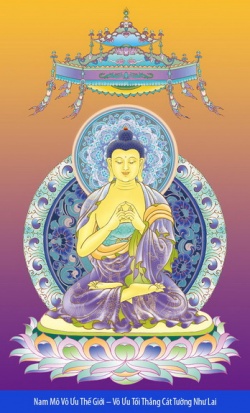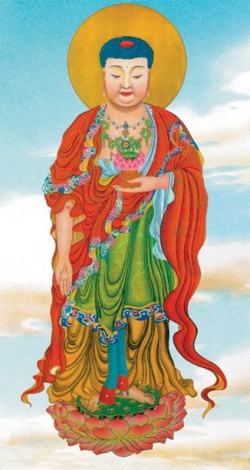Theravada and Mahasanghika : The Great Schism
Written by Red Zambala
During the lifetime of Buddha Shakyamuni in the 6th century BCE in India there was hardly any writing used.
All Buddha’s speeches, discourses, teachings were memorized by his students and passed on orally through succession of teachers (acariyaparampara) the first 400 years.
Often serious attention was not given for the proper preservation of his actual words, not to speak about their interpretations.
Mahaparinirvana Sutra records that Buddha himself had prophesied that his teachings might be misrepresented in the future and recommended to his disciples to verify in four ways (cattaro mahapadesa)in his teachings if he has actually taught that.
Buddha’s prophesy came true after his passing into Mahaparinirvana.
Hundred years after Buddha passed away, the first serious disagreements arouse between monks about the actual words of Buddha, and it was decided to hold the Second Buddhist Council.
The reasons for the Second Council are told differently in Hinayana and Mahayana sources.
Theravada related sources as The Cullavagga and the Ceylonese chronicles record that the reasons has been the breach of Vinaya rules by Buddhist monks from Vajjian sect and to examine the validity of the ten practices (dasa vatthuni):
1.Singilonakappa—the practice of carrying salt in a horn, i. e. storing articles of food;
2. Dvangulakappa—the practice of taking meals when the shadow is two fingers broad, i. e. taking meals after midday ;
3. Gamantarakappa - the practice of going to an adjacent village and taking meals there the same day for the second time;
4. Avasakappa—the observance of the Uposatha ceremonies in various places in the same parish (sima) ;
5. Anuma-tikappa — doing something and obtaining its sanction later;
6. Acinnakappa—the customary practices as precedent;
7. Amathitakappa—drinking of butter-milk after meals;
8. Jalogimpatum—drinking of toddy;
9. Adasakam nisidanam—use of a rug without a fringe and
10. Jatarupara/atam— acceptance of gold and silver.
The works of Vasumitra, Bhavya and Vinitadeva preserved in Tibetan and Chinese translations provides quite a different account.
According to them the Council was convened due to the differences of opinions among the monks regarding the five dogmas propounded by Mahadeva:
1.An Arhat may commit a sin under unconscious temptation.
2.One may be an Arhat and not know it.
3.An Arhat may have doubts on matters of doctrine.
4. One cannot attain Arhatship without the aid of a teacher and
5.'The noble ways' may begin by shout, that is, one meditating seriously on religion may make such an exclamation as 'How sad !' How sad!' and by so doing attain progress towards perfection—the path is attained by an exclamation of astonishment.
Nowadays it is believed there have been actually 2 councils.
The first in Vaishali, where some group of monks were condemned what was believed to be a minor infringements of Vinaya (monastic rules), and another some 35 years later at Pātaliputra , under the Nandin ruler Mahapadma , another council about fallibility and imperfection of Arhats.
The main discussion objects in councils were Vinaya rules.
Nowadays scholars believe the group known as Sthavira (Elders) wanted to tighten monastic discipline even more as it was given by Buddha himself and add more rules.
But a large part of Buddhist community opposed to it.
The earliest surviving account of the schism the Śāriputraparipṛcchā contains an account in which an old monk rearranges and augments the traditional Vinaya, consequently causing dissention among the monks that required the king's arbitration and eventually precipitating the first schism.
Śāriputraparipṛcchā says:
He copied and rearranged our Vinaya, developing and augmenting what Kāśyapa had codified and which was called "Vinaya of the Great Assembly" (Mahāsāṃghavinaya). [...]
The king considered that [the doctrines of the two parties represented] were both the work of the Buddha, and since their preferences were not the same, [the monks of the two camps] should not live together.
As those who studied the old Vinaya were in the majority, they were called the Mahāsāṃghika; those who studied the new Vinaya were in the minority, but they were all Sthaviras; thus they were named Sthavira.
This coincides also with chronicles of Chinese monk Faxian (法显) (337 – c. 422 CE) who travelled to India in order to procure the Mahāsāṃghika Vinaya, which was regarded as the original.
Those who were expelled continued to practice and teach Buddhism and their views became very popular and soon a new Buddhist Council was convened.
Ten thousand monks participated in it and it is known as Mahasangiti (Great Council).
Monks who joined this council are known as Mahasanghikas.
This way the first great schism happened and 2 groups formed – Theravada (from Sanskrit name “sthaviravada” – “the Elders teaching”.) and Mahasanghika (Great Community).
But it was not the last one.
Soon Theravada was split into 12 sub-sects and Mahasanghika into 6.
But these different sects could not maintain their separate existence for long.
Most of them either disappeared or merged with other groups soon after their origin.
Only four schools of philosophy survived –
Vaibhasika,
Sautrantika,
Madhyamaka and
Yogacara.

